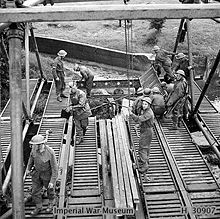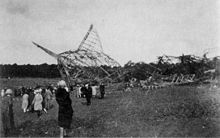- Charles Inglis (engineer)
-
Sir Charles Edward Inglis OBE (pronounced Ingels[1]) (31 July 1875 – 19 April 1952) was a British civil engineer.[2][3] Inglis spent much of his life as a lecturer and academic at King's College Cambridge and made several important studies into the effects of vibration and defects on the strength of plate steel. Inglis served in the Royal Engineers during the First World War and invented a lightweight, reusable steel bridge – the precursor and inspiration for the Bailey bridge of the Second World War. His military service was rewarded with an appointment as an Officer of the Order of the British Empire (OBE).
He was involved in the Institution of Naval Architects, Institution of Civil Engineers, Institution of Structural Engineers, Institution of Waterworks Engineers and the British Waterworks Association and sat on several of their councils. Perhaps his greatest professional achievement was his period as president of the Institution of Civil Engineers for the 1941-2 session. He also sat on the board of inquiry looking into the loss of airship R101 and was chair of a Ministry of War Transport railway modernisation committee in 1946.
Contents
Early life
Charles was born to Dr Alexander Inglis, a general practitioner in Worcester, and his first wife, Florence on 31 July 1875 and was their second eldest son. Charles was not expected to survive the birth and so was hurriedly baptised in the drawing room, Florence died from complications eleven days later.[2] He studied at Cheltenham College from 1889 to 1894 and was elected head boy in his final year. He received a scholarship to study the Mathematics Tripos at King's College, Cambridge in 1894, was 22nd wrangler in 1897 and graduated with a first class degree in Mechanical Sciences in 1898.[4]
Apprenticeship
Inglis began work as an apprentice for the firm of John Wolfe-Barry and partners after graduation. He started out as a draughtsman in the drawing office for several months before working with Alexander Gibb on an extension to the Metropolitan Line between Whitechapel and Bow. Inglis was responsible for the design and supervision of all of the bridges on the route. It was during this time that he began his lifelong study of vibration and its effects on materials.[2][3]
Academic life
In 1901 Inglis was made a fellow of King's College after writing a thesis entitled The Balancing of Engines, the first general treatment of the subject which was becoming more and more important due to the increasing speeds of locomotives. In the same year he returned to the college to act as assistant to James Alfred Ewing, professor of mechanism and applied mechanics. He left this post in 1903 to become the first Director of Naval Education at the Admiralty, his successor Bertram Hopkinson appointed him as a lecturer, continuing his association with the university, and the two worked together on the effects of vibration.[2][3] In 1913 he published a paper on the stress caused to plates by defects[2][3] which has been described as his most important contribution to engineering.[3][5]
Military service
Shortly before the outbreak of the First World War, Inglis, in conjunction with the Royal Engineers detachment of the Officer Training Corps at Cambridge, designed a temporary, reusable steel bridge which was adopted by the army.[2][3] This design was made up of triangular truss sections and was highly successful, still being in use at the start of the Second World War and influencing Sir Donald Bailey who designed the Bailey Bridge as a replacement.[1] He was first commissioned as second lieutenant in the OTC in 1909.[6] He volunteered for active service in the British Army in 1914 and he was officially listed as an Assistant Instructor in the School of Military Engineering, with the temporary rank of lieutenant,[7] and in 1916 was placed in charge of bridge design and supply at the War Office.[8][9] He was initially promoted to captain on 6 May 1916,[10] and this was confirmed with an appointment as a Staff Captain in the War Office on 26 June 1917,[11] and he retired with the rank of Major in 1918 and service was rewarded with his appointment as an Officer of the Order of the British Empire (OBE).[2][3]
Return to academia
Inglis returned to Cambridge in 1919 and was appointed professor of Mechanism and Applied Mechanics.[12] On 25 March 1919 he was elected head of the engineering department following the death of Bertram Hopkinson in an air crash. From 1923 he was involved with the analysis of vibration and its effect on railway bridges for British Railways, publishing A mathematical treatise on vibrations in railway bridges as a book on the matter in 1934 and also submitting several papers on the matter to the Institution of Civil Engineers. In all Inglis published 25 books or academic papers on a wide range of engineering topics.[2] In 1926 he was appointed to a Royal Commission on cross-river traffic in London.[13] In 1929 he was awarded the honorary degree of Doctor of Laws by the University of Edinburgh.[12] From 1931 to 1947 he was a member of the London, Midland and Scottish Railway's Advisory Committee on Scientific Research and conducted many experiments in his laboratory at Cambridge.[2] He was due to retire from the university in 1940 but was persuaded to remain for another three years so that John Baker could be appointed in his stead.[8] He was knighted in the 1945 King's Birthday Honours.[14] He published Applied mechanics for engineers in 1951, following which he spent three months as a visiting professor at the University of Witwatersrand in South Africa before returning to England.[2][3]
Professional institutions
Inglis was very active professionally and served on the councils of the Institution of Naval Architects, Institution of Civil Engineers (ICE), Institution of Structural Engineers and the Institution of Waterworks Engineers.[2] He was elected president of the British Waterworks Association in 1935 and served as president of the ICE during the 1941-2 session.[15] He was an active member of several committees including the board of inquiry looking into the loss of the airship R101 and was chair of the Railway Committee appointed to advise the Minister of War Transport on railway modernisation in 1946.[2]
Personal life
Inglis was a keen sportsman and enjoyed long distance running, walking, mountaineering and sailing. He very nearly achieved his blue for long distance running at university but was forced to withdraw from the race with a pulled muscle. He married Eleanor Moffatt in 1901 with whom he would have two daughters. He lived in Cambridge until 1904 when he built a house at Grantchester. His wife died on 1 April 1952 and he followed her eighteen days later.[2][3]
References
- ^ a b Basingstoke canal News article on Inglis Bridge
- ^ a b c d e f g h i j k l m Royal Society Obituary
- ^ a b c d e f g h i Baker, J. F.; rev. Heyman, Jacques (2004). "‘Inglis, Sir Charles Edward (1875–1952)’". Oxford Dictionary of National Biography. Oxford University Press. doi:10.1093/ref:odnb/34100. http://www.oxforddnb.com/view/article/34100. Retrieved 2008-04-18.
- ^ Inglis, Charles Edward in Venn, J. & J. A., Alumni Cantabrigienses, Cambridge University Press, 10 vols, 1922–1958.
- ^ de With, Gijsbertus (2006), Structure, Deformation, and Integrity of Materials, Wiley-VCH, p. 654, ISBN 3527314261
- ^ London Gazette: no. 28260. p. 4576. 15 June 1909. Retrieved 2008-04-17.
- ^ London Gazette: (Supplement) no. 28968. p. 9110. 6 November 1914. Retrieved 2008-04-17.
- ^ a b Cambridge University biography
- ^ London Gazette: (Supplement) no. 29453. p. 1103. 25 January 1916. Retrieved 2008-04-17.
- ^ London Gazette: no. 29568. p. 4457. 5 May 1916. Retrieved 2008-04-17.
- ^ London Gazette: (Supplement) no. 30203. p. 7594. 24 July 1917. Retrieved 2008-04-17.
- ^ a b University of Edinburgh honorary graduation
- ^ London Gazette: no. 33186. pp. 4957–4958. 27 July 1926. Retrieved 2008-04-17.
- ^ London Gazette: (Supplement) no. 37119. pp. 2933–2934. 8 June 1945. Retrieved 2008-04-17.
- ^ Watson, Garth (1988), The Civils, London: Thomas Telford Ltd, p. 253, ISBN 0-727-70392-7
Professional and academic associations Preceded by
Leopold Halliday SavilePresident of the Institution of Civil Engineers
November 1941 – November 1942Succeeded by
John Edward ThornycroftCategories:- British civil engineers
- Presidents of the Institution of Civil Engineers
- 1875 births
- 1952 deaths
- Alumni of King's College, Cambridge
- Old Cheltonians
- People from Worcester
Wikimedia Foundation. 2010.


